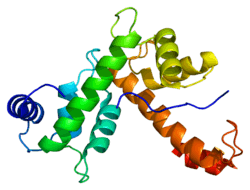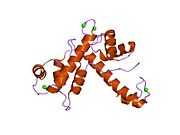PDCD6
Programmed cell death protein 6 is a protein that in humans is encoded by the PDCD6 gene.[1]
This gene encodes a calcium-binding protein belonging to the penta-EF-hand protein family. Calcium binding is important for homodimerization and for conformational changes required for binding to other protein partners. This gene product participates in T cell receptor-, Fas-, and glucocorticoid-induced programmed cell death. In mice deficient for this gene product, however, apoptosis was not blocked suggesting this gene product is functionally redundant.[2]
Interactions
PDCD6 has been shown to interact with ASK1,[3] PDCD6IP,[4][5] Fas receptor,[6] ANXA11[5] and PEF1.[7]
References
- ↑ Vito P, Lacana E, D'Adamio L (February 1996). "Interfering with apoptosis: Ca(2+)-binding protein ALG-2 and Alzheimer's disease gene ALG-3". Science 271 (5248): 521–5. doi:10.1126/science.271.5248.521. PMID 8560270.
- ↑ "Entrez Gene: PDCD6 programmed cell death 6".
- ↑ Hwang, In-Sik; Jung Yong-Sam; Kim Eunhee (October 2002). "Interaction of ALG-2 with ASK1 influences ASK1 localization and subsequent JNK activation". FEBS Lett. (Netherlands) 529 (2–3): 183–7. doi:10.1016/S0014-5793(02)03329-X. ISSN 0014-5793. PMID 12372597.
- ↑ Vito, P; Pellegrini L; Guiet C; D'Adamio L (January 1999). "Cloning of AIP1, a novel protein that associates with the apoptosis-linked gene ALG-2 in a Ca2+-dependent reaction". J. Biol. Chem. (UNITED STATES) 274 (3): 1533–40. doi:10.1074/jbc.274.3.1533. ISSN 0021-9258. PMID 9880530.
- ↑ 5.0 5.1 Satoh, Hirokazu; Shibata Hideki; Nakano Yoshimi; Kitaura Yasuyuki; Maki Masatoshi (March 2002). "ALG-2 interacts with the amino-terminal domain of annexin XI in a Ca(2+)-dependent manner". Biochem. Biophys. Res. Commun. (United States) 291 (5): 1166–72. doi:10.1006/bbrc.2002.6600. ISSN 0006-291X. PMID 11883939.
- ↑ Jung, Y S; Kim K S; Kim K D; Lim J S; Kim J W; Kim E (October 2001). "Apoptosis-linked gene 2 binds to the death domain of Fas and dissociates from Fas during Fas-mediated apoptosis in Jurkat cells". Biochem. Biophys. Res. Commun. (United States) 288 (2): 420–6. doi:10.1006/bbrc.2001.5769. ISSN 0006-291X. PMID 11606059.
- ↑ Kitaura, Y; Matsumoto S; Satoh H; Hitomi K; Maki M (April 2001). "Peflin and ALG-2, members of the penta-EF-hand protein family, form a heterodimer that dissociates in a Ca2+-dependent manner". J. Biol. Chem. (United States) 276 (17): 14053–8. doi:10.1074/jbc.M008649200. ISSN 0021-9258. PMID 11278427.
Further reading
- Krebs J, Klemenz R (2001). "The ALG-2/AIP-complex, a modulator at the interface between cell proliferation and cell death? A hypothesis". Biochim. Biophys. Acta 1498 (2–3): 153–61. doi:10.1016/S0167-4889(00)00091-4. PMID 11108958.
- Maruyama K, Sugano S (1994). "Oligo-capping: a simple method to replace the cap structure of eukaryotic mRNAs with oligoribonucleotides". Gene 138 (1–2): 171–4. doi:10.1016/0378-1119(94)90802-8. PMID 8125298.
- Suzuki Y, Yoshitomo-Nakagawa K, Maruyama K et al. (1997). "Construction and characterization of a full length-enriched and a 5'-end-enriched cDNA library". Gene 200 (1–2): 149–56. doi:10.1016/S0378-1119(97)00411-3. PMID 9373149.
- Vito P, Pellegrini L, Guiet C, D'Adamio L (1999). "Cloning of AIP1, a novel protein that associates with the apoptosis-linked gene ALG-2 in a Ca2+-dependent reaction". J. Biol. Chem. 274 (3): 1533–40. doi:10.1074/jbc.274.3.1533. PMID 9880530.
- Tarabykina S, Møller AL, Durussel I et al. (2000). "Two forms of the apoptosis-linked protein ALG-2 with different Ca(2+) affinities and target recognition". J. Biol. Chem. 275 (14): 10514–8. doi:10.1074/jbc.275.14.10514. PMID 10744743.
- Chen B, Borinstein SC, Gillis J et al. (2000). "The glioma-associated protein SETA interacts with AIP1/Alix and ALG-2 and modulates apoptosis in astrocytes". J. Biol. Chem. 275 (25): 19275–81. doi:10.1074/jbc.M908994199. PMID 10858458.
- Kitaura Y, Matsumoto S, Satoh H et al. (2001). "Peflin and ALG-2, members of the penta-EF-hand protein family, form a heterodimer that dissociates in a Ca2+-dependent manner". J. Biol. Chem. 276 (17): 14053–8. doi:10.1074/jbc.M008649200. PMID 11278427.
- Suzuki H, Fukunishi Y, Kagawa I et al. (2001). "Protein–Protein Interaction Panel Using Mouse Full-Length cDNAs". Genome Res. 11 (10): 1758–65. doi:10.1101/gr.180101. PMC 311163. PMID 11591653.
- Jung YS, Kim KS, Kim KD et al. (2001). "Apoptosis-linked gene 2 binds to the death domain of Fas and dissociates from Fas during Fas-mediated apoptosis in Jurkat cells". Biochem. Biophys. Res. Commun. 288 (2): 420–6. doi:10.1006/bbrc.2001.5769. PMID 11606059.
- Kitaura Y, Satoh H, Takahashi H et al. (2002). "Both ALG-2 and peflin, penta-EF-hand (PEF) proteins, are stabilized by dimerization through their fifth EF-hand regions". Arch. Biochem. Biophys. 399 (1): 12–8. doi:10.1006/abbi.2001.2736. PMID 11883899.
- Satoh H, Shibata H, Nakano Y et al. (2002). "ALG-2 interacts with the amino-terminal domain of annexin XI in a Ca(2+)-dependent manner". Biochem. Biophys. Res. Commun. 291 (5): 1166–72. doi:10.1006/bbrc.2002.6600. PMID 11883939.
- Chatellard-Causse C, Blot B, Cristina N et al. (2002). "Alix (ALG-2-interacting protein X), a protein involved in apoptosis, binds to endophilins and induces cytoplasmic vacuolization". J. Biol. Chem. 277 (32): 29108–15. doi:10.1074/jbc.M204019200. PMID 12034747.
- Hwang IS, Jung YS, Kim E (2002). "Interaction of ALG-2 with ASK1 influences ASK1 localization and subsequent JNK activation". FEBS Lett. 529 (2–3): 183–7. doi:10.1016/S0014-5793(02)03329-X. PMID 12372597.
- Satoh H, Nakano Y, Shibata H, Maki M (2002). "The penta-EF-hand domain of ALG-2 interacts with amino-terminal domains of both annexin VII and annexin XI in a Ca2+-dependent manner". Biochim. Biophys. Acta 1600 (1–2): 61–7. doi:10.1016/S1570-9639(02)00445-4. PMID 12445460.
- Krebs J, Saremaslani P, Caduff R (2002). "ALG-2: a Ca2+ -binding modulator protein involved in cell proliferation and in cell death". Biochim. Biophys. Acta 1600 (1–2): 68–73. doi:10.1016/S1570-9639(02)00446-6. PMID 12445461.
- Strausberg RL, Feingold EA, Grouse LH et al. (2003). "Generation and initial analysis of more than 15,000 full-length human and mouse cDNA sequences". Proc. Natl. Acad. Sci. U.S.A. 99 (26): 16899–903. doi:10.1073/pnas.242603899. PMC 139241. PMID 12477932.
- Tomsig JL, Snyder SL, Creutz CE (2003). "Identification of targets for calcium signaling through the copine family of proteins. Characterization of a coiled-coil copine-binding motif". J. Biol. Chem. 278 (12): 10048–54. doi:10.1074/jbc.M212632200. PMID 12522145.
- Hansen C, Tarabykina S, la Cour JM et al. (2003). "The PEF family proteins sorcin and grancalcin interact in vivo and in vitro". FEBS Lett. 545 (2–3): 151–4. doi:10.1016/S0014-5793(03)00518-0. PMID 12804766.
External links
- PDCD6 human gene location in the UCSC Genome Browser.
- PDCD6 human gene details in the UCSC Genome Browser.
| |||||||||

